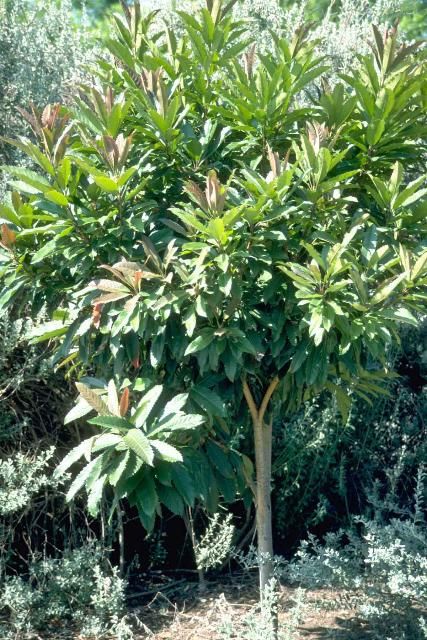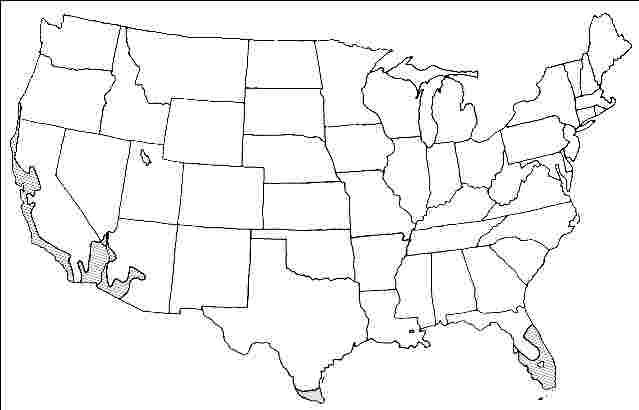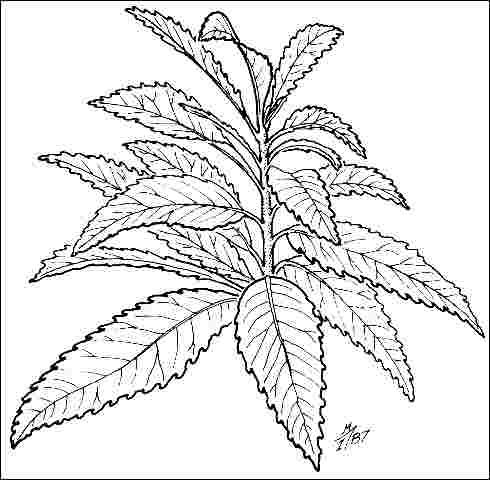Introduction
This rounded, spreading, evergreen, small tree reaches a height of 15 to 20 feet with a 10 to 15-foot spread in a sunny spot. Taller trees can be found in partially shaded sites where the tree reaches skyward for light. The large, 8-inch-long leaves are a bright red-bronze or coppery color when young and maintain this color for a considerable period of time but eventually turn dark green. The small white, fragrant flowers are produced on terminal panicles in spring and are followed by small, inedible fruits. Bronze loquat can be espaliered, grown in patio containers, or used as a specimen. Although shrubby with a tight, compact, dense crown, it can easily be trained into a small tree form and used for a small shade tree near a deck or patio.

Credit: Ed Gilman, UF/IFAS
General Information
Scientific name: Eriobotrya deflexa
Pronunciation: air-ee-oh-BOT-ree-uh dee-FLECK-suh
Common name(s): Bronze loquat
Family: Rosaceae
USDA hardiness zones: 9B through 11 (Fig. 2)
Origin: not native to North America
Invasive potential: little invasive potential
Uses: hedge; trained as a standard; container or planter; specimen; espalier; deck or patio; street without sidewalk; screen; tree lawn 3–4 feet wide; highway median; tree lawn > 6 ft wide; tree lawn 4–6 feet wide
Availability: somewhat available, may have to go out of the region to find the tree

Description
Height: 15 to 20 feet
Spread: 10 to 20 feet
Crown uniformity: symmetrical
Crown shape: vase, round
Crown density: dense
Growth rate: moderate
Texture: coarse
Foliage
Leaf arrangement: alternate (Fig. 3)
Leaf type: simple
Leaf margin: dentate, serrate
Leaf shape: oblong, elliptic (oval)
Leaf venation: pinnate
Leaf type and persistence: broadleaf evergreen, evergreen
Leaf blade length: 8 to 12 inches
Leaf color: green
Fall color: no color change
Fall characteristic: not showy

Flower
Flower color: white/cream/gray
Flower characteristics: showy
Fruit
Fruit shape: round, oval
Fruit length: less than .5 inch
Fruit covering: fleshy
Fruit color: orange, yellow
Fruit characteristics: attracts birds; not showy; fruit/leaves not a litter problem
Trunk and Branches
Trunk/bark/branches: branches droop; not showy; typically one trunk; thorns
Pruning requirement: needed for strong structure
Breakage: resistant
Current year twig color: green
Current year twig thickness: thick
Wood specific gravity: unknown
Culture
Light requirement: full sun, partial sun, or partial shade
Soil tolerances: clay; sand; loam; alkaline; acidic; well-drained
Drought tolerance: moderate
Aerosol salt tolerance: high
Other
Roots: not a problem
Winter interest: no
Outstanding tree: no
Ozone sensitivity: unknown
Verticillium wilt susceptibility: unknown
Pest resistance: sensitive to pests/diseases
Use and Management
Its neat habit and compact growth make loquat an ideal specimen or patio shade tree, and it can be used as a residential street tree or median strip tree in areas where overhead space is limited. But an adequate clear trunk needs to be developed early in the life of the tree to provide for vehicle clearance. Branches will have to be pruned to grow up, as they tend to droop with time under the weight of the developing branch. It is not suited for planting next to the street if trucks pass close to the tree since adequate clearance is not possible but it is successful in wide median strips. It also blends well into informal shrubbery borders and the fruit is attractive to wildlife. It espaliers well against a sunny wall, and makes a good screen due to its dense canopy. Sprouts along the trunk can be a maintenance nuisance.
Providing best fruit and form when grown in full sun, loquat can tolerate partial shade and a variety of well-drained soils. It grows well on soils with a high pH and maintains the characteristic dark green foliage. Clay soil is acceptable as long as there is sufficient slope to allow surface water to run away from the root system. It often looks best in the southern portion of its range when given some shade in the afternoon, especially if it is not irrigated. Loquat should be well-watered until established, but can then survive periodic droughts. Do not overfertilize since this could increase sensitivity to fire blight disease. Loquat may live only 20 to 30-years so it should not be considered a permanent fixture in the landscape. It performs well along the coast with some protection from salty air.
The cultivar 'Bronze Improved' has bronze-colored new growth and grows 20 feet tall with a 15-foot spread.
Propagation is by seed.
Pests and Diseases
This tree is usually pest-free.
Two common problems are fireblight and root rot on wet soils. To reduce fireblight problems, provide good air circulation and keep away from other fireblight hosts, such as pyracantha, pears, etc. If leaves and stems blacken from the top downward, prune back 1-foot or more into healthy wood. Sterilize shears between cuts.